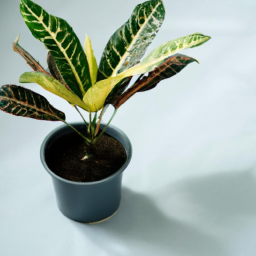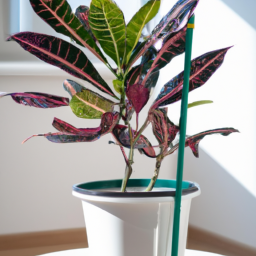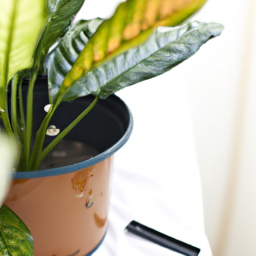
Are you looking to add a pop of color and tropical vibes to your indoor space? If so, Croton indoor plant care is a topic you’ll want to familiarize yourself with. Croton plants, with their vibrant and colorful leaves, are a popular choice for indoor plant enthusiasts looking to bring a touch of the tropics into their homes. In this blog post, we’ll cover everything you need to know to keep your Croton plant happy and thriving in your indoor environment. From lighting and watering requirements to common issues and troubleshooting tips, we’ve got you covered. So, grab your gardening gloves and let’s dive into the world of Croton indoor plant care!
Watering and Light Requirements for Croton Indoor Plants
Watering
1. Understanding Croton’s Watering Needs
Croton plants require regular watering to thrive indoors. However, it’s essential not to overwater them, as this can lead to root rot. The key is to keep the soil consistently moist but not waterlogged. Before watering, always check the top inch of the soil to see if it’s dry to the touch. If it is, it’s time to water your Croton plant.
2. Best Practices for Watering Croton Plants
When watering your Croton plant, make sure to water the soil directly and avoid getting water on the leaves, as this can cause fungal diseases. Use room temperature water to avoid shocking the plant’s roots. Water your Croton plant thoroughly until you see water draining out of the bottom of the pot. This ensures that the roots are receiving enough moisture.
3. Signs of Overwatering and Underwatering
Overwatering can lead to yellowing leaves, wilting, and root rot. On the other hand, underwatering can cause the leaves to droop and curl. It’s essential to pay attention to your Croton plant’s watering needs and adjust your watering schedule accordingly.
Light Requirements
1. Importance of Light for Croton Plants
Croton plants require bright, indirect light to thrive indoors. Place your Croton plant near a window where it can receive plenty of sunlight throughout the day. However, be cautious of direct sunlight, as it can scorch the leaves. If your Croton plant isn’t receiving enough light, you may notice its leaves losing their vibrant colors.
2. Providing Adequate Light for Your Croton Plant
If your Croton plant isn’t getting enough light, consider supplementing with artificial light. You can use grow lights to provide the necessary light intensity for your plant. Rotate your Croton plant periodically to ensure all sides receive equal light exposure. Regularly dust the leaves to allow maximum light absorption.
3. Signs of Insufficient Light
If your Croton plant isn’t receiving enough light, you may notice its leaves becoming dull and losing their variegation. The plant may also become leggy and stretch towards the light source. If you observe these signs, consider moving your Croton plant to a brighter location or providing artificial light.

Soil and Fertilization Tips for Healthy Croton Plants
Choosing the Right Soil
When it comes to caring for your Croton indoor plant, one of the most important factors to consider is the type of soil you use. Crotons thrive in well-draining soil that is rich in organic matter. A good potting mix for Crotons should be a combination of peat moss, perlite, and vermiculite. These ingredients help to ensure proper drainage while also providing essential nutrients for your plant.
It’s important to avoid using heavy, compacted soils that can lead to root rot. Crotons are sensitive to overwatering, so having a well-draining soil mix is crucial for their overall health. You can also add some sand to the potting mix to further improve drainage.
When repotting your Croton, make sure to choose a pot that has drainage holes at the bottom. This will help prevent water from pooling at the bottom of the pot and causing root rot. Overall, choosing the right soil mix is essential for the health and vitality of your Croton plant.
Fertilizing Your Croton Plant
In addition to using the right soil mix, fertilizing your Croton plant is another key aspect of its care routine. Crotons are heavy feeders and require regular fertilization to thrive. During the growing season, which typically runs from spring to fall, you should fertilize your Croton plant every two weeks with a balanced liquid fertilizer.
It’s important to dilute the fertilizer to half the recommended strength to avoid burning the roots of your plant. You can also use a slow-release fertilizer to provide a steady source of nutrients over a longer period of time. Make sure to follow the instructions on the fertilizer package carefully to avoid over-fertilizing your Croton.
During the winter months when your Croton is not actively growing, you can reduce the frequency of fertilization to once a month. This will help prevent nutrient buildup in the soil and ensure that your plant remains healthy and vibrant. Overall, proper fertilization is essential for promoting growth and maintaining the overall health of your Croton plant.
Tips for Healthy Croton Plants
In addition to using the right soil mix and fertilizing your Croton plant regularly, there are a few other tips you can follow to ensure that your plant remains healthy and vibrant. Firstly, make sure to place your Croton in a location where it receives bright, indirect sunlight. Crotons thrive in bright light but can become sunburned if exposed to direct sunlight for extended periods.
Secondly, be mindful of the humidity levels around your Croton plant. Crotons prefer high humidity, so consider using a humidifier or placing a tray of water near your plant to increase moisture in the air. You can also mist your Croton plant regularly to help maintain optimal humidity levels.
Lastly, keep an eye out for common pests such as spider mites and mealybugs, which can be problematic for Croton plants. If you notice any signs of pest infestation, treat your plant with insecticidal soap or neem oil to eliminate the pests.
By following these soil and fertilization tips, along with proper care and maintenance, you can ensure that your Croton indoor plant remains healthy and vibrant for years to come.

Common Pests and Diseases to Watch Out for When Caring for Croton Indoor Plants
Pests
When caring for your Croton indoor plants, it’s important to be aware of common pests that can wreak havoc on your plant’s health. One of the most common pests that affect Croton plants is spider mites. These tiny pests can be difficult to spot with the naked eye, but you may notice webbing on the leaves or tiny yellow or brown spots. To get rid of spider mites, you can try spraying your plant with neem oil or insecticidal soap.
Another common pest that can bother Croton plants is mealybugs. These small, white, cottony insects can be found on the leaves and stems of your plant. To get rid of mealybugs, you can use a cotton swab dipped in rubbing alcohol to remove them from your plant.
Aphids are another pest that can infest Croton plants. These small, pear-shaped insects can be found on the undersides of leaves and can cause damage by sucking the sap from your plant. To get rid of aphids, you can try spraying your plant with a mixture of water and dish soap.
Diseases
In addition to pests, Croton plants can also be susceptible to diseases. One common disease that affects Croton plants is powdery mildew. This fungal disease appears as a white, powdery substance on the leaves of your plant. To treat powdery mildew, you can try spraying your plant with a fungicide or removing infected leaves.
Another disease that can affect Croton plants is root rot. This disease is caused by overwatering and can lead to the roots of your plant becoming mushy and discolored. To prevent root rot, make sure to allow the soil to dry out between waterings and ensure that your plant is in a well-draining pot.
Leaf spot is another common disease that can affect Croton plants. This fungal disease appears as dark spots on the leaves of your plant and can cause them to yellow and drop off. To treat leaf spot, you can try removing infected leaves and improving air circulation around your plant.
Prevention
To prevent pests and diseases from affecting your Croton indoor plants, it’s important to practice good plant care habits. Make sure to regularly inspect your plant for any signs of pests or diseases and take action immediately if you notice any issues. Additionally, make sure to water your plant properly, avoid overwatering, and provide your plant with adequate sunlight and humidity levels.
By following these tips and being proactive in caring for your Croton indoor plants, you can help keep them healthy and thriving for years to come. Remember, prevention is key when it comes to keeping pests and diseases at bay, so stay vigilant and attentive to your plant’s needs.
In a Nutshell
So you’ve decided to bring a croton plant into your home – great choice! Croton plants are known for their vibrant, colorful leaves that can add a pop of color to any room. But, like any plant, they require proper care to thrive.
To keep your croton plant looking its best, make sure it gets plenty of bright, indirect sunlight and water it when the top inch of soil feels dry. Croton plants also benefit from regular misting to increase humidity, as they are tropical plants. Keep an eye out for pests like spider mites and mealybugs, and treat them promptly if you see any signs of infestation. With a little TLC, your croton plant will be a beautiful addition to your indoor garden.
Here are some FAQs you’d be interested in:
Q1. How often should I water my Croton indoor plant?
A1. It is important to keep the soil of your Croton plant consistently moist, but not waterlogged. Water your Croton plant when the top inch of soil feels dry to the touch. Typically, this means watering your plant every 1-2 weeks, depending on the humidity levels in your home.
Q2. What is the best location for my Croton indoor plant?
A2. Croton plants thrive in bright, indirect light. Place your Croton plant near a window where it can receive plenty of sunlight, but make sure to avoid direct sunlight as it can scorch the leaves. A room with east or west-facing windows is ideal for your Croton plant.
Q3. How can I prevent my Croton plant from dropping its leaves?
A3. Croton plants are sensitive to changes in their environment, which can cause them to drop their leaves. To prevent this, make sure to keep your Croton plant in a consistent temperature and humidity level. Avoid placing your plant near drafts or heating vents, as this can stress the plant and cause leaf drop.
Q4. How do I fertilize my Croton indoor plant?
A4. Fertilize your Croton plant every 2-4 weeks during the growing season (spring and summer) with a balanced liquid fertilizer. Make sure to dilute the fertilizer to half the recommended strength to avoid overfeeding your plant. Do not fertilize your Croton plant during the winter months when it is not actively growing.
Q5. How do I prune my Croton indoor plant?
A5. Pruning your Croton plant is important to maintain its shape and encourage new growth. Use sharp, clean scissors to trim back any leggy or overgrown branches. Make sure to prune just above a leaf node to encourage branching. You can also remove any dead or yellowing leaves to improve the overall appearance of your plant.

James Wong is a renowned ethnobotanist, plant scientist, and local television presenter. With a passion for demystifying plant science, he is known for translating complex botanical concepts into practical advice for everyday plant enthusiasts. James’s expertise spans from traditional gardening to cutting-edge plant technologies, making his insights accessible and informative.


